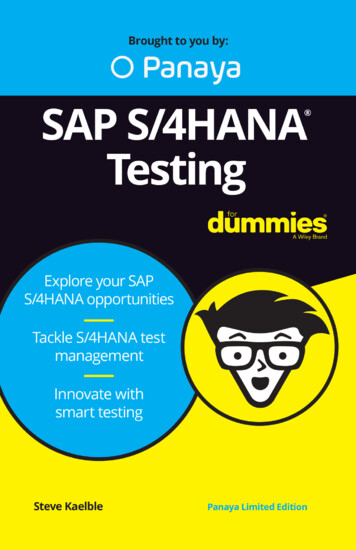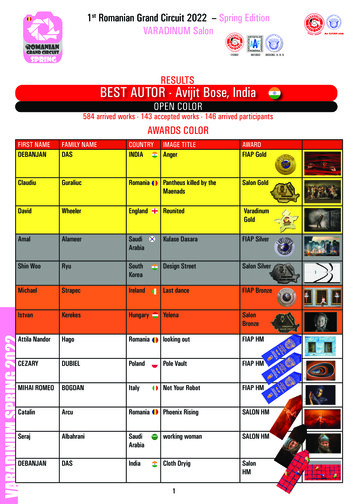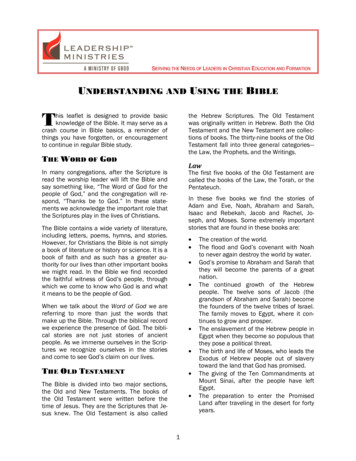
Transcription
These materials are 2022 John Wiley & Sons, Inc. Any dissemination, distribution, or unauthorized use is strictly prohibited.
EnterpriseContainerManagementSUSE Special Editionby Tom Callway and Peter SmailsThese materials are 2022 John Wiley & Sons, Inc. Any dissemination, distribution, or unauthorized use is strictly prohibited.
Enterprise Container Management For Dummies ,SUSE Special EditionPublished byJohn Wiley & Sons, Inc.111 River St.Hoboken, NJ 07030-5774www.wiley.comCopyright 2022 by John Wiley & Sons, Inc., Hoboken, New JerseyNo part of this publication may be reproduced, stored in a retrieval system or transmitted in anyform or by any means, electronic, mechanical, photocopying, recording, scanning or otherwise,except as permitted under Sections 107 or 108 of the 1976 United States Copyright Act, withoutthe prior written permission of the Publisher. Requests to the Publisher for permission should beaddressed to the Permissions Department, John Wiley & Sons, Inc., 111 River Street, Hoboken, NJ07030, (201) 748-6011, fax (201) 748-6008, or online at http://www.wiley.com/go/permissions.Trademarks: Wiley, For Dummies, the Dummies Man logo, The Dummies Way, Dummies.com,Making Everything Easier, and related trade dress are trademarks or registered trademarks of JohnWiley & Sons, Inc. and/or its affiliates in the United States and other countries, and may not beused without written permission. All other trademarks are the property of their respective owners.John Wiley & Sons, Inc., is not associated with any product or vendor mentioned in this book.LIMIT OF LIABILITY/DISCLAIMER OF WARRANTY: WHILE THE PUBLISHER AND AUTHORS HAVEUSED THEIR BEST EFFORTS IN PREPARING THIS WORK, THEY MAKE NO REPRESENTATIONSOR WARRANTIES WITH RESPECT TO THE ACCURACY OR COMPLETENESS OF THE CONTENTS OFTHIS WORK AND SPECIFICALLY DISCLAIM ALL WARRANTIES, INCLUDING WITHOUT LIMITATIONANY IMPLIED WARRANTIES OF MERCHANTABILITY OR FITNESS FOR A PARTICULAR PURPOSE.NO WARRANTY MAY BE CREATED OR EXTENDED BY SALES REPRESENTATIVES, WRITTENSALES MATERIALS OR PROMOTIONAL STATEMENTS FOR THIS WORK. THE FACT THAT ANORGANIZATION, WEBSITE, OR PRODUCT IS REFERRED TO IN THIS WORK AS A CITATION AND/OR POTENTIAL SOURCE OF FURTHER INFORMATION DOES NOT MEAN THAT THE PUBLISHERAND AUTHORS ENDORSE THE INFORMATION OR SERVICES THE ORGANIZATION, WEBSITE, ORPRODUCT MAY PROVIDE OR RECOMMENDATIONS IT MAY MAKE. THIS WORK IS SOLD WITHTHE UNDERSTANDING THAT THE PUBLISHER IS NOT ENGAGED IN RENDERING PROFESSIONALSERVICES. THE ADVICE AND STRATEGIES CONTAINED HEREIN MAY NOT BE SUITABLE FORYOUR SITUATION. YOU SHOULD CONSULT WITH A SPECIALIST WHERE APPROPRIATE. FURTHER,READERS SHOULD BE AWARE THAT WEBSITES LISTED IN THIS WORK MAY HAVE CHANGEDOR DISAPPEARED BETWEEN WHEN THIS WORK WAS WRITTEN AND WHEN IT IS READ.NEITHER THE PUBLISHER NOR AUTHORS SHALL BE LIABLE FOR ANY LOSS OF PROFIT OR ANYOTHER COMMERCIAL DAMAGES, INCLUDING BUT NOT LIMITED TO SPECIAL, INCIDENTAL,CONSEQUENTIAL, OR OTHER DAMAGES.ISBN 978-1-119-93328-1 (pbk); ISBN 978-1-119-93329-8 (ebk)For general information on our other products and services, or how to create a customFor Dummies book for your business or organization, please contact our Business DevelopmentDepartment in the U.S. at 877-409-4177, contact info@dummies.biz, or visit www.wiley.com/go/custompub. For information about licensing the For Dummies brand for products or services,contact BrandedRights&Licenses@Wiley.com.Publisher’s AcknowledgmentsSome of the people who helped bring this book to market include the following:Project Editor: Elizabeth KuballAcquisitions Editor: Ashley CoffeyEditorial Manager: Rev MengleSenior Client Account Manager:Matt CoxProduction Editor:Saikarthick KumarasamyThese materials are 2022 John Wiley & Sons, Inc. Any dissemination, distribution, or unauthorized use is strictly prohibited.
IntroductionIf you’re exploring containers and enterprise container management (ECM) software, you’ve come to the right place. Aspart of your exploration, you’ve most likely come acrossKubernetes, because it’s impossible to talk about ECM withouttalking about it. Kubernetes is not just the leading containerorchestration solution — it’s the standard. Technology employeesof all stripes love working with Kubernetes:»» Developers love the extensibility of Kubernetes because itgives them maximum agility and flexibility when deliveringcloud-native applications, whether on premises, in the cloud,or at the edge.»» Information technology operations (ITOps) teams loveKubernetes because it helps boost productivity, reducescosts and risks, and moves organizations closer to achievingtheir hybrid cloud goals.»» CEOs and CIOs love Kubernetes because it helps signifi-cantly increase the agility and efficiency of their softwaredevelopment teams, enabling them to reduce the time andcomplexity associated with putting differentiated applications into production.Simply put, Kubernetes makes it easier to manage software complexity. As enterprise applications become more complex, development and operations (DevOps) teams need a tool that canorchestrate that complexity. They need a way to launch all theservices dependent on these applications, making sure the appsand services are healthy and can connect to one another.This book provides you with a basic road map to successfullydevelop an ECM strategy and select the appropriate Kubernetesmanagement solution to address your needs. We include threedetailed case studies from companies leading the way withKubernetes and Rancher as their solution of choice. Our hope isthat IT professionals and others who lead an organization of anysize will see how other technology leaders have used Kubernetesto improve their operations.Introduction1These materials are 2022 John Wiley & Sons, Inc. Any dissemination, distribution, or unauthorized use is strictly prohibited.
Foolish AssumptionsTo help you get the most out of this book, we make some assumptions about you:»» We assume that you already have some basic familiarity withcontainers and Kubernetes or you’ve at least heard theterms mentioned in passing. We do not assume that youknow all there is to know about Kubernetes or that you’veeven heard of Rancher.»» We assume that regardless of whether you head up yourDevOps or IT department or work in an executive capacity,you’ve come to this book ready to solve a problem and youwant to determine whether Kubernetes, Rancher, and otherrelated technologies are the solutions you’re seeking.Icons Used in This BookThis book uses the following icons to highlight paragraphs thathave a little something “extra” about them:The Tip icon calls your attention to information that may helpmake your Kubernetes venture lift off a little more smoothly.The Remember icon highlights information that is so important,it’s worth repeating — and remembering!The Warning icon calls attention to pitfalls you may encounter inyour Kubernetes implementation and explains how to avoid them.Beyond This BookInterested in learning more? The Rancher blog (www.suse.com/c/rancherblog), Rancher docs (https://rancher.com/docs), andRancher community links (www.suse.com/community) are chockfull of helpful information — and searchable!2Enterprise Container Management For Dummies, SUSE Special EditionThese materials are 2022 John Wiley & Sons, Inc. Any dissemination, distribution, or unauthorized use is strictly prohibited.
IN THIS CHAPTER»» Understanding why IT teams loveKubernetes»» Assessing your progress on yourKubernetes journey»» Establishing who owns your strategy»» Setting goals»» Meeting your standardization andinnovation needs»» Training your teamsChapter1Creating an EnterpriseKubernetes StrategyTo understand why Kubernetes is so popular, you first needto know why containers have risen dramatically in popularity. Containers provide a consistent way to package application components and their dependencies into a single object thatcan run in any environment. By packaging code and its dependencies into containers, a development team can use standardizedunits of code as consistent building blocks. The container runs thesame way in any environment and gives some applications theability to scale to any size.Development teams use containers to package entire applicationsand move them to the cloud without making any code changes.Containers also simplify the process of building workflows forapplications that run between on-premises and cloud environments, enabling the smooth operation of almost any hybridenvironment.CHAPTER 1 Creating an Enterprise Kubernetes Strategy3These materials are 2022 John Wiley & Sons, Inc. Any dissemination, distribution, or unauthorized use is strictly prohibited.
So, why Kubernetes? It depends on who you ask:»» Enterprises love Kubernetes because it helps softwaredevelopment teams make their applications more efficient,scalable, available, and portable. And with tools andpractices such as continuous integration/continuous delivery(CI/CD), GitOps, automation, and configuration management,teams can reduce the time and complexity associated withputting differentiated applications into production whileimproving agility and time to market.»» Information technology operations (ITOps) teams loveKubernetes because it helps boost productivity, reduce costsand risks, and move organizations closer to achieving theirhybrid cloud goals.»» Developers love the extensibility of Kubernetes, which givesthem maximum agility and flexibility when deliveringcloud-native applications.Simply put, Kubernetes solves much of the complexity of managing software development at scale in a multi-cloud landscape. Asenterprise applications become more complex, development andoperations teams need a tool to orchestrate that complexity. Theyneed a way to launch all the services dependent on these applications, ensuring the apps and services are healthy and can connectto one another.Knowing Where You Are on YourKubernetes JourneyBuilding an enterprise Kubernetes strategy starts with understanding how Kubernetes can help your organization. Whetheryou’re using it to help build the applications required to hit business goals or choosing to build the software needed to achieve yourbusiness goals, you’ll need to decide which platforms Kubernetescan benefit and plan your needs for the next five to ten years.Over the last several years, accessing Kubernetes has becomemuch easier. Open-source tools make provisioning and upgrading a Kubernetes cluster (a set of nodes that enable you to runcontainerized applications) quick and easy. Cloud providers are4Enterprise Container Management For Dummies, SUSE Special EditionThese materials are 2022 John Wiley & Sons, Inc. Any dissemination, distribution, or unauthorized use is strictly prohibited.
now offering Kubernetes as a hosted service. Any team usingAmazon Web Services (AWS), Google Cloud Platform (GCP), orMicrosoft Azure can provision a Kubernetes cluster in minutesusing their respective Amazon Elastic Kubernetes Service (EKS),Google Kubernetes Engine (GKE), and Azure Kubernetes Service(AKS) services.Organizations that run Kubernetes often approach it the sameway as when they built OpenStack or other shared, centralizedservices. ITOps teams typically use Kubernetes to build largeclusters and then offer development teams shared access to themthrough Kubernetes namespaces. Namespaces and cgroups enablecluster administrators to control access to cluster resources basedon usage quotas and resource limits. Namespaces help delivera reasonably well-isolated experience for each team that needsaccess to Kubernetes.Other organizations have left it to individual departments ordevelopment and IT operations (DevOps) teams to decide how andwhere to use Kubernetes. These organizations often have dozens of clusters deployed across public clouds and company datacenters.As you document and understand where Kubernetes is running inyour enterprise, make sure that you have individuals with expertise in containerization — or hire them. As you progress in building your strategy, developing a team of Kubernetes advocatesacross your organization will be critical to driving adoption.COLLABORATING ACROSS TEAMSTension can develop between software development teams whoneed to run Kubernetes in a certain way to accomplish a developmentgoal and an IT department that prioritizes maintaining security andcontrol over how Kubernetes gets implemented.Development teams want flexibility. They need the tools to consumestorage, security, and infrastructure as a service. The collaborationbetween development teams and ITOps, with the support of solutionslike Rancher and Longhorn, will ensure that developers have the bestsolution possible to consume all these services.(continued)CHAPTER 1 Creating an Enterprise Kubernetes Strategy5These materials are 2022 John Wiley & Sons, Inc. Any dissemination, distribution, or unauthorized use is strictly prohibited.
(continued)On the other hand, IT teams are especially nervous about clustersthat are deployed and left unpatched and unmanaged. They want tocentralize the operations and policy around clusters and restrictaccess to only those teams that require it.If Kubernetes and containers are going to become the primaryplatform for running applications across any infrastructure, ITOps(or DevOps) must collaborate with developers to build a strategy forKubernetes that satisfies both their needs.Defining Who Owns Your StrategyNew technologies like Kubernetes are exciting to work with, andit isn’t uncommon for many teams to try to own their company’sKubernetes strategy — individual DevOps teams, shared servicesgroups, central IT, cloud platform, or platform-as-a-service(PaaS) groups.Two teams that often lead the Kubernetes strategy are the sharedservices team (responsible for supporting developers and DevOps)and the central IT team (responsible for computing platforms).Putting either team in charge of Kubernetes strategy provides thefollowing benefits:»» Shared services: The shared services team brings keyinsights into how an organization is modernizing itsapproach to application development, as well as therequirements teams have identified they need in aKubernetes platform. They often understand other keysystems that have been built for DevOps, such as CI/CDtools, development environments, data services, andapplication monitoring tools. Whether these teams own thestrategy or simply contribute to it, they represent at the veryleast one of the primary consumers of containers in theorganization. They should be a critical part of developingyour organization’s strategy.»» Central IT: The central IT team, focused on cloud computingand other computing platforms, is also a logical team to leada Kubernetes strategy. They have a strong understanding of6Enterprise Container Management For Dummies, SUSE Special EditionThese materials are 2022 John Wiley & Sons, Inc. Any dissemination, distribution, or unauthorized use is strictly prohibited.
platform operations, infrastructure, security, multi-tenancy,and existing IT investments, and they usually have significantexperience running critical projects. A project led by the ITplatforms team will benefit from their understanding of thebroad requirements of many different teams across a large,complex organization.Projects coming out of central IT often suffer from too littleengagement with end users and too much influence from existingtechnology vendors. These teams often have very little experiencewith the latest application architectures and benefit enormouslyfrom working closely with teams leading innovation aroundapplication development.Successful teams often bring together talent from across theorganization and collaborate to determine requirements. Still,investing in a strategy and building a platform means workingwithin budget constraints, so it’s most common for one team totake the lead on delivering on the strategy.Prioritizing Your GoalsBuilding an enterprise container management strategy meansprioritizing your goals. These goals will depend on what you’retrying to accomplish. For example, if your team sets out to useKubernetes to optimize infrastructure costs, you’ll probably focuson building big clusters and trying to get as much density as possible out of them.If your team focuses instead on using Kubernetes to accelerateinnovation, you’ll take a different approach, emphasizing flexibility and delivering more tooling around Kubernetes, such asmonitoring and CI/CD integration. With this approach, you wouldhave a multi-cluster strategy, with more smaller clusters. Thisway of working will provide higher flexibility and freedom foryour developers, while at the same time giving you better availability for your apps and avoiding vendor lock-in.To prioritize your goals, try to understand the potential ofKubernetes, and imagine how your organization may be using itin the future. In five years, for example, you may use Kubernetesto do any of the following:CHAPTER 1 Creating an Enterprise Kubernetes Strategy7These materials are 2022 John Wiley & Sons, Inc. Any dissemination, distribution, or unauthorized use is strictly prohibited.
»» Create microservices-centric applications. Kubernetes is agreat way to run modern, microservices-centric applications.It offers a rich set of functionalities that allow teams todetermine how different services within modern applicationsare run, handle unexpected events, connect with each other,and connect with other applications and applicationprogramming interfaces (APIs).»» Rapidly deploy Kubernetes clusters. Today, every majorcloud provider has made it easy to deploy Kubernetesclusters within minutes. Teams are continuously buildingnew applications, deploying them to different clouds, andusing Kubernetes to run them. Between clusters used fordevelopment, staging, and production, and the need todeploy Kubernetes clusters across different data centers andcloud providers, it isn’t hard to imagine that even the mostwell-organized company is still running dozens ofKubernetes clusters.»» Move onto the edge. The same modern applicationarchitectures that we think of as cloud native are nowbeginning to move out of the data center. Teams buildingsoftware for factories, hospitals, and stores now want to runapplications with rich data analytics and complex architectures as close to their customers and production facilities aspossible. Running applications this way is referred to as“running on the edge.”»» Develop for single-node devices. Even single-node devicessuch as point-of-sale terminals, outdoor advertising, medicaldevices, 5G-enabled communication equipment, securitycameras, or automobiles now benefit from the ability todeploy and run applications easily using microservices. We’rewitnessing the sprawl of tens of thousands of edge deployments, all running as individual Kubernetes clusters, andpresenting an API that needs to be managed.Between clusters running in different clouds, data centers, andthe edge, it’s almost certain that your organization will be running more than one Kubernetes cluster. Unless you know you’llonly be running a single application in one location, it probablymakes sense to build your Kubernetes strategy with an expectation that you’ll need to be able to easily provision and managemultiple Kubernetes clusters running in many different places.8Enterprise Container Management For Dummies, SUSE Special EditionThese materials are 2022 John Wiley & Sons, Inc. Any dissemination, distribution, or unauthorized use is strictly prohibited.
Weighing Standardizationagainst InnovationRegardless of who owns your strategy, one of the critical questions that will emerge is how much standardization is possiblewithout impacting innovation. Many teams will have experiencedprojects around OpenStack and PaaS that struggled to get adoption because users weren’t able to get enough flexibility to deploythe next-generation applications they were building.With Kubernetes, there is enough flexibility in the platformand the ecosystem to satisfy any team. Exposing that flexibilityis critical to delivering value. Any strategy that abstracts awayKubernetes will probably face resistance from your most innovative teams. At the same time, the flexibility of Kubernetes and itsecosystem can be a hindrance to some teams looking for a platform to just run standard apps.One of the most exciting developments in the Kubernetes space inthe past few years has been the emergence of lightweight projects that run on Kubernetes but provide frameworks that simplifyapplication management. These approaches enable containers to“scale to zero” and provide simple declarative languages to build,connect, scale, and monitor services. They can deliver a powerfulexperience without requiring a deep understanding of the underlying technology, which can benefit teams using CI/CD and stateless applications.SUSE’s Epinio project (https://epinio.io) is an example of thisapproach to running containers that simplify some of the complexity of Kubernetes.As you build your Kubernetes strategy, consider blending the bestof a decentralized approach with enough controls and management to ensure compliance and remove repetitive tasks. Try tocentralize and automate everyday tasks such as Kubernetes cluster life-cycle management, role-based access control (RBAC)policies, infrastructure management, and other Day 2 operations.At the same time, give your teams options for where they can getaccess to Kubernetes clusters and whether they can use a sharedcluster or a dedicated cluster. Focus primarily on maintainingCHAPTER 1 Creating an Enterprise Kubernetes Strategy9These materials are 2022 John Wiley & Sons, Inc. Any dissemination, distribution, or unauthorized use is strictly prohibited.
visibility into all the provisioned clusters, not necessarily forcingteams to use a set of preapproved clusters in a specified way.Preparing Your TeamsA critical part of any Kubernetes strategy is determining howyou’ll train your teams to leverage Kubernetes. If you find thatyour enterprise already has some staff members with expertisein containers or Kubernetes, consider how you can incorporatethem into your initiative. This doesn’t mean necessarily pullingthem off their existing work, but perhaps they can work as partof the team setting requirements, evaluating tools, or developingpolicies.Regardless of your team’s skill level, you’ll almost certainly haveteam members who need to be trained on either using or administering Kubernetes. Luckily, there is no shortage of Kubernetestraining providers and online courses, including those offered bythe SUSE & Rancher Community (www.suse.com/community).As you build your core team of early Kubernetes admins and users,consider setting a goal to train and certify as many members ofyour team as possible. The tests are rigorous and help you ensurethat you build strong internal knowledge about using containersand Kubernetes.After you have some initial expertise, you may want to wait to dofurther training until you’re out of the design phase of your strategy and bringing on more teams to work with the specific implementations of Kubernetes your organization is adopting.10Enterprise Container Management For Dummies, SUSE Special EditionThese materials are 2022 John Wiley & Sons, Inc. Any dissemination, distribution, or unauthorized use is strictly prohibited.
IN THIS CHAPTER»» Explaining enterprise containermanagement»» Fostering innovation in multipleenvironments»» Providing comprehensive control andvisibility»» Ensuring robust global security andeffective governance»» Providing developers with platformchoices»» Deciding between an on-premisesplatform and a hosted platform»» Understanding the value of experienceChapter2Building an EnterpriseGrade KubernetesEnvironmentChapter 1 covers the basics of building an enterpriseKubernetes strategy that considers how your organizationwill use Kubernetes over the next five years. We also discussthe importance of maintaining flexibility while at the same timeproviding centralized controls and management when you buildthis strategy.This chapter covers the next step in that process. You findout how IT operations and development teams should examine their options for managing containers at scale across theirCHAPTER 2 Building an Enterprise-Grade Kubernetes Environment11These materials are 2022 John Wiley & Sons, Inc. Any dissemination, distribution, or unauthorized use is strictly prohibited.
organization. In this book, we refer to a class of software calledenterprise container management (ECM).Introducing Enterprise ContainerManagementAn ECM platform is a software platform that provides management capabilities for a multi-cluster Kubernetes environment andthe containerized applications running within it. An ECM platform also provides the tools and application programming interfaces (APIs) needed to integrate with the Cloud Native ComputingFoundation (CNCF) ecosystem projects that help developers andoperations teams to be effective.An ECM platform contains functional layers that work in concert to deliver all the capabilities you need to build and managea Kubernetes infrastructure and the workloads running on it (seeFigure 2-1). The following sections describe the role each layerplays and discuss why that layer’s role is important.FIGURE 2-1: The anatomy of an enterprise container management platform.The rest of this chapter discusses the key components of an ECMplatform and what to look for when choosing a solution. You seeexamples of how Rancher, the world’s most popular open-sourceECM platform, can help implement your Kubernetes strategy inyour enterprise.12Enterprise Container Management For Dummies, SUSE Special EditionThese materials are 2022 John Wiley & Sons, Inc. Any dissemination, distribution, or unauthorized use is strictly prohibited.
Enabling Innovation EverywherePossibly the most powerful benefit of Kubernetes is its transformational ability to enable innovation everywhere. The CNCF runsa software conformance program to certify Kubernetes offerings.Conformance ensures that vendor and community versions ofKubernetes support the required APIs.Using certified distributions, organizations can develop applications and then deploy and run them anywhere — from desktop todata center, the cloud, and the edge. Using certified distributionsis, therefore, an innovation driver: You’re using standard APIsand open-source software practices.Be sure that your Kubernetes distribution is certified by theCNCF. This certification ensures that the distribution is consistent with upstream Kubernetes and quickly supports the latestfeatures being developed in the community.In the world of Kubernetes distributions, one size does not fit all.Don’t be fooled by vendors saying that all you need is “their” distribution. Be smart: Select the best distribution for the job basedon where your application will be running.Here are some places where you may run your applications.Public cloudsTo reduce the time and complexity of deploying Kubernetes,many organizations choose to deploy their clusters using publiccloud-based infrastructures such as Amazon Web Services (AWS),Google Cloud Platform (GCP), and Microsoft Azure. Most publiccloud providers have developed their own certified Kubernetesdistributions optimized for that cloud. However, operators stillchoose a multi-cloud approach to minimize reliance on a soleinfrastructure solution. So, it’s important that your ECM platform supports Kubernetes in any public or private cloud environment and treats popular hosted distributions like Amazon ElasticKubernetes Service (EKS), Google Kubernetes Engine (GKE), andAzure Kubernetes Service (AKS) as first-class citizens.As of Rancher 2.6, users have full life-cycle management of EKS,GKE, and AKS clusters. This includes configuring and provisioning, infrastructure and resource management, monitoringCHAPTER 2 Building an Enterprise-Grade Kubernetes Environment13These materials are 2022 John Wiley & Sons, Inc. Any dissemination, distribution, or unauthorized use is strictly prohibited.
and logging, communication, scanning, security and upgradingdirectly from Rancher’s unified platform experience and intuitiveuser interface (UI). Table 2-1 shows how Rancher 2.6 supports fulllife-cycle management of these hosted Kubernetes distributions.TABLE 2-1Rancher 2.6 Provides EKS, GKE, and AKSCluster /GKS withRancher 2.6EKS/AKS/GKEOnlyConfigurationand rovisioning of anyclusters via Rancherenhanced importproficiency of existingEKS/AKS/GKE clustersStandard guration ofunderlyinginfrastructureStandard consoleVisualizeKubernetesresourcesRancher cluster-leveluser experience (UX)explores allKubernetes resourcesKubectlIntegratedmonitoring andloggingEnhanced monitoring(Prometheus)Manual installSimplifiedservice meshRancher-supportedIstioManual installCentralizedtooling andvisibilityCentralized rolebased access control(RBAC) policyKubernetes nativeSecureEnhanced logging(Fluentbit/Fluentd)Third-party toolsThird-party toolsThird-party toolsProvider specificProvider specificProvider specificCentralized authCenter for InternetSecurity (CIS) scanningOpen Policy Agent(OPA) Gatekeeper14Enterprise Container Management For Dummies, SUSE Special EditionThese materials are 2022 John Wiley & Sons, Inc. Any dissemination, distribution, or unauthorized use is strictly prohibited.
Life-CycleManagementFeaturesRequiredEKS/AKS/GKS withRancher radesRancher graphicaluser interface (GUI)/API upgrades ofcreated and importedclustersStandard consoleEasy access toCNCF tools andthird-partyappsRancher certifiedpackagesHelmAppsCustom RanchercatalogsThird-party t
units of code as consistent building blocks. The container runs the same way in any environment and gives some applications the ability to scale to any size. Development teams use containers to package entire applications and move them to the cloud without making any code changes. Containers also simplify the process of building workflows for











